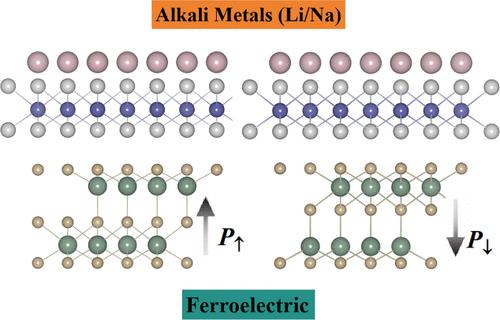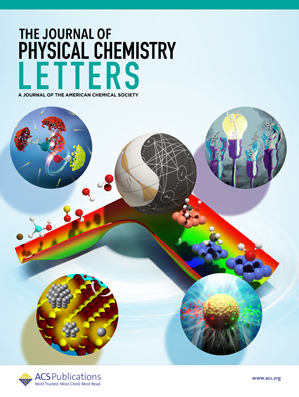Multiferroic Tuning of Magnetic Anisotropy in MnTe2 Monolayer with Li/Na Adsorption
IF 4.8
2区 化学
Q2 CHEMISTRY, PHYSICAL
引用次数: 0
Abstract
Two-dimensional (2D) magnetic materials with tunable magnetic anisotropy energy (MAE) are of great scientific interest and hold immense promise for ultracompact spintronic devices with lower energy consumption and higher storage density. Here, we demonstrate a practical approach for manipulating MAE in layered MnTe2 through the alkali metal adsorption and ferroelectric (FE) polarization effect. Our results reveal colossal MAE values of up to −12.428 erg/cm2 under Li/Na adsorption, accompanied by a spin reorientation and enhanced ferromagnetic (FM) coupling stability. Their negative MAE show a linear enhancement in response to the external strain. Moreover, we find that the FE In2Se3 substrate enhances the perpendicular magnetic anisotropy (PMA) of MnTe2 up to 2.318 erg/cm2 depending on the polarization direction. Ferroelectric switching at In2Se3-based interfaces could also induce significant MAE changes with the value of 3.838 erg/cm2. We elucidate that the underlying mechanisms for these modulations are primarily attributed to alterations in the electron occupancy of interfacial Te1-derived py and pz states, which affect their competitive spin–orbit coupling (SOC) strengths. These findings highlight the potential of interfacial engineering in tailoring magnetism in 2D materials, opening exciting possibilities for the development of advanced spintronic devices with enhanced functionality.

具有Li/Na吸附的MnTe2单层磁性各向异性的多铁调谐
具有可调谐磁各向异性能(MAE)的二维(2D)磁性材料具有很大的科学价值,并且在具有低能耗和高存储密度的超紧凑自旋电子器件中具有巨大的前景。在这里,我们展示了一种通过碱金属吸附和铁电(FE)极化效应来操纵层状MnTe2中的MAE的实用方法。我们的研究结果表明,在Li/Na吸附下,MAE值高达- 12.428 erg/cm2,伴随着自旋重定向和增强的铁磁(FM)耦合稳定性。它们的负MAE对外部应变的响应呈线性增强。此外,我们发现FE In2Se3衬底可以根据极化方向提高MnTe2的垂直磁各向异性(PMA),最高可达2.318 erg/cm2。在基于in2se3的界面上进行铁电开关也可以引起显著的MAE变化,其值为3.838 erg/cm2。我们阐明了这些调制的潜在机制主要归因于界面te1衍生的py和pz态的电子占用的改变,这影响了它们的竞争自旋轨道耦合(SOC)强度。这些发现突出了界面工程在定制二维材料磁性方面的潜力,为开发具有增强功能的先进自旋电子器件开辟了令人兴奋的可能性。
本文章由计算机程序翻译,如有差异,请以英文原文为准。
求助全文
约1分钟内获得全文
求助全文
来源期刊

The Journal of Physical Chemistry Letters
CHEMISTRY, PHYSICAL-NANOSCIENCE & NANOTECHNOLOGY
CiteScore
9.60
自引率
7.00%
发文量
1519
审稿时长
1.6 months
期刊介绍:
The Journal of Physical Chemistry (JPC) Letters is devoted to reporting new and original experimental and theoretical basic research of interest to physical chemists, biophysical chemists, chemical physicists, physicists, material scientists, and engineers. An important criterion for acceptance is that the paper reports a significant scientific advance and/or physical insight such that rapid publication is essential. Two issues of JPC Letters are published each month.
 求助内容:
求助内容: 应助结果提醒方式:
应助结果提醒方式:


